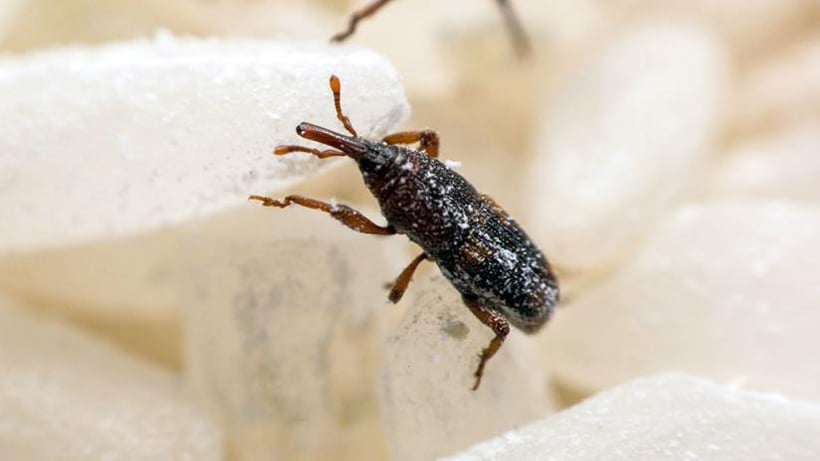
Weevils are a type of beetle known for their long snout and their affinity for getting into dried goods such as flour, rice or cornmeal. There are more than 1,000 species, and the most commonly found weevil in food businesses is called the “stored product weevil” because they infest stored grains, seeds and other dried food products. They are often discovered in flour, cereal, pasta, powdered milk, nuts, popcorn, spices and baking mixes.
Why is preventing a weevil infestation important?
Unlike other kinds of pests, the weevil doesn’t just find its way into food containers or bags — it actually lives inside the food, with the female chewing a hole into a grain of rice, for example, depositing an egg, sealing up the hole and leaving the egg behind. The larva then feeds on the grain until it’s fully grown, when the bug will eat its way out of the grain. Females emit pheromones that attract males, and the cycle continues.
Weevils can live about eight months. While they’re not dangerous, they are certainly a nuisance — they contaminate food with their faeces and cast skins, which makes whole packages or even pantries of food inedible.
It’s clear why a weevil infestation can be a major problem for a food business. Beyond being unsightly, eradicating an infestation is expensive, as the contaminated foods must be thrown out, causing food waste and mounting costs to the business.
Spot the signs of an infestation
While the eggs are almost invisible to the naked eye, grown weevils can be different colours, usually brown or black, and have different body shapes, with most being slender and oval-shaped. They are roughly three millimetres (mm) to more than 10mm long.
They’re usually found by observing dried goods and other foodstuffs in storage. Frequently check these foods to make sure they’re free of weevils.
Prevent weevils from entering in the first place
Stop weevils from entering your business by:
- Checking deliveries thoroughly: Any staff member receiving dried goods should inspect the delivery upon arrival. Open the lids to look closely at the product and check for small movements.
- Storing dry goods in tightly covered containers: This will prevent weevils from getting in and stop contamination between foodstuffs.
- Cleaning and sanitising containers between use: A good idea all the time, proper cleaning and sanitising practices are especially helpful in preventing pests.
- Following FIFO: First In, First Out means first using items that were delivered earliest. The longer a dried good is untouched and unused, the more likely it will end up as a breeding ground for nasty pests!
What to do about a weevil problem
If you know you already have weevils, you’ll need to identify the affected products and get rid of them. Your business’s Food Safety Program should instruct workers to check dry products regularly, and it should also include instructions on corrective actions to take if a pest problem is uncovered.
After you discard affected products, you need to clean and sanitise the containers these products were stored in, and examine surrounding containers and areas of the business in case the weevils found their way in more foodstuffs than you initially realised.
No matter what pest you’re up against in your food business, the Australian Institute of Food Safety (AIFS) can help. Refer to the AIFS Guide to Pest Prevention and Control for tips and tricks to ensure your establishment stays pest-free and profitable.




